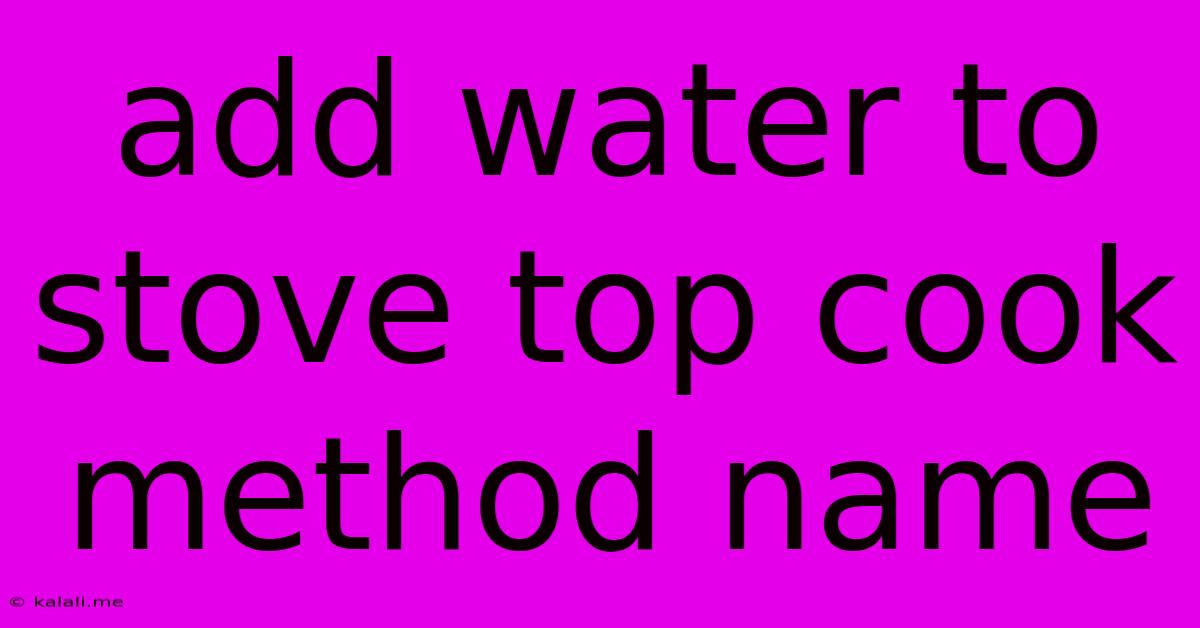Add Water To Stove Top Cook Method Name
Kalali
Jun 04, 2025 · 3 min read

Table of Contents
Adding Water to Your Stove Top Cooking: Methods & Considerations
Adding water to your stovetop cooking methods might seem simple, but it can significantly impact the outcome of your dish. Whether you're simmering a stew, boiling pasta, or sautéing vegetables, understanding how and when to add water is crucial for achieving the perfect texture and flavor. This guide explores various stovetop cooking methods that involve adding water and provides helpful tips for success. This will cover everything from basic boiling to more nuanced techniques, helping you master the art of water-based stovetop cooking.
Understanding the Role of Water in Stovetop Cooking
Water plays several vital roles in stovetop cooking:
- Heat Transfer: Water efficiently transfers heat, ensuring even cooking of ingredients.
- Texture: The amount of water used affects the final texture of your dish. Too much can result in mushy food, while too little can lead to burning or uneven cooking.
- Flavor: Water helps to extract flavors from ingredients, creating richer and more flavorful dishes. Adding it at different stages can influence the final taste.
- Steam Cooking: Water creates steam, which gently cooks delicate ingredients and prevents them from sticking to the pan.
Stovetop Cooking Methods Involving Water:
Here are some common stovetop cooking methods that utilize water:
1. Boiling: A Foundation for Many Dishes
Boiling is a fundamental method where water is heated to its boiling point (100°C or 212°F). This is used for cooking pasta, potatoes, eggs, and more. The key is to ensure enough water to fully submerge the ingredients and maintain a consistent boil.
- Tip: Add a generous amount of salt to the boiling water to season your food and improve its taste.
2. Simmering: Gentle Cooking for Flavor Development
Simmering involves maintaining a gentle bubbling action, typically below a full boil. This method is ideal for stews, soups, and sauces, allowing flavors to meld together slowly and evenly. It's important to maintain a low, consistent simmer to avoid scorching.
- Tip: Start with a higher heat to bring the liquid to a simmer, then reduce the heat to the lowest setting that maintains the simmering action.
3. Steaming: Healthy & Flavorful Cooking
Steaming utilizes the steam created by boiling water to cook ingredients indirectly. This gentle method preserves nutrients and texture, perfect for vegetables and delicate seafood. Use a steamer basket placed over boiling water, ensuring the ingredients are not submerged.
- Tip: Add aromatic herbs or spices to the water to infuse your food with flavor.
4. Poaching: Gentle Submersion in Liquid
Poaching involves gently cooking ingredients in a simmering liquid, such as water, broth, or wine. This method is suitable for delicate items like eggs, fish, and fruits, resulting in a tender and moist final product.
- Tip: Maintain a gentle simmer and avoid vigorous bubbling to prevent the food from breaking apart.
5. Blanching: A Quick Dip in Boiling Water
Blanching involves briefly submerging ingredients in boiling water, then immediately transferring them to an ice bath to stop the cooking process. This technique is commonly used for vegetables to brighten their color, soften them slightly, and remove impurities.
- Tip: Don't over-blanch! A quick dip is all that's needed to achieve the desired effect.
Conclusion:
Mastering the art of adding water to your stovetop cooking is a fundamental skill for any cook. Understanding the different methods and their nuances will allow you to create a wide variety of delicious and perfectly cooked dishes. Remember to consider the amount of water, the heat level, and the cooking time to achieve optimal results. Experiment with these techniques, and soon you'll be confidently adding water to your stovetop creations with delicious results.
Latest Posts
Latest Posts
-
Heat Pump Water Heaters Vs Gas Water Heaters
Jun 06, 2025
-
Minecraft Teleport Player To Tamed Pet
Jun 06, 2025
-
When You Re Available Next Or Next Availble
Jun 06, 2025
-
How To Disable Ds4 In Steam
Jun 06, 2025
-
Toilet Not Flushing And Filling Up With Water
Jun 06, 2025
Related Post
Thank you for visiting our website which covers about Add Water To Stove Top Cook Method Name . We hope the information provided has been useful to you. Feel free to contact us if you have any questions or need further assistance. See you next time and don't miss to bookmark.